It’s probably very cold where you live, damn cold. One has to think positive, though! Consider this: the weather is miserable, and you’re probably stuck at home, unable to go to school or work. Well, what better excuse to wrap yourself up and play some Genesis? Nature’s on your side, when you think of it!
Wonder Boy in Monster World By Ken Horowitz
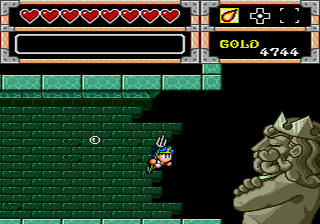
The first time I beat this game was when my friend Miguel and I stayed up all night to play the import version. Then, I finished it when it came stateside. I’ve been meaning to go back to it ever since, but something has always come up, and I put it on the back burner for another day. This month (finally) ended up being the time to stop procrastinating and finally play through Wonder Boy in Monster World again. Ironically, it was purely accidental. I booted it up to hear the music and have something in the background while I cleaned some new cartridges that arrived in the mail. I had no intention of actually playing.
As if Wonder Boy would be ignored like that! The sweet melodies of its soundtrack and the wonderfully (no pun intended) distributed color palette made me pick up the controller and hit start. About three hours later, I was watching the end credits. Few games can do that to me, but the ones that can manage to do it every time. Wonder Boy in Monster World is definitely one of those games.
Playing through it, I found myself surprised at just how well it’s aged overall. The graphics are still beautiful, the music excellent, the gameplay as great as always. The game is simply timeless. It’s one of those rare treasures that has gone unnoticed by far too many people for too long.
I’m glad I played it through to the end. It gave me a greater appreciation of those games that marked my life during the 16-bit era by actually living up to my warm and fuzzy memories. If you haven’t played this one yet, you are doing yourself a disservice. It’s really a delightful little game.
Uncharted Waters By Sebastian Sponsel
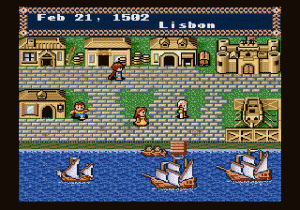 Well, after playing and enjoying the sequel New Horizons very much, I decided to give the original a try. I have some time on my hands, the setting is pretty novel (you’re portraying a young member of the Portuguese nobility during the Age of Discovery in 1502), and the open world gameplay allows for a versatile approach. You can be a merchant, an explorer, a pirate, or all of the above. You literally have the entire world open to exploration (at least the parts accessible by sea). You may even encounter monsters! What’s not to like?
Well, after playing and enjoying the sequel New Horizons very much, I decided to give the original a try. I have some time on my hands, the setting is pretty novel (you’re portraying a young member of the Portuguese nobility during the Age of Discovery in 1502), and the open world gameplay allows for a versatile approach. You can be a merchant, an explorer, a pirate, or all of the above. You literally have the entire world open to exploration (at least the parts accessible by sea). You may even encounter monsters! What’s not to like?
Well, let’s put it this way: to say the game is off to a slow start is a bit of an understatement. If already sunken many hours into the game, but aside from the first few lines of dialogue right at the beginning and a few rumors in taverns, I haven’t even gotten a glimpse of any story yet. Compared to the sequel, there isn’t much happening here. So far, I’m limited to slooooooooowly exploring the surrounding area, trying to find some decent trade routes and building up my fortunes and fleet. Entering a fight or setting out to explore new worlds? Still out of the question. It’s very time consuming, but the way the pieces fit together is still kind of intriguing. But at the rate things are going and with the rather limited time I have on my hands, I expect I’ll still be playing this game two months from now. If I manage to stick with it for that long.
Doom By The Coop
So far this year, I’ve basically avoided the Genesis section of the “can we beat them all” contest. After slamming down 109 games, I needed a break to play something else. And like any other genius, I chose to play some games on what else, but 32X. Of course! I thought. What better way to get away from the system for a spell, than to play the games of one of its add-ons? It’s perfect!
 One of the games I sat down with was the 32X port of Doom. It took a few tries, but I bested the game and added it to my small list of 32X accomplishments for the add-on’s “can we beat them all” contest (next to After Burner Complete and Zaxxon’s Motherbase 2000). Took some getting used to again, after playing the PC original a fair bit lately. Not just control-wise, but visual and gameplay-wise as well. With so many things missing and altered in the 32X port, it was a little jarring coming back to it. The levels that make up the third episode are gone entirely, the atmospheric lighting is gone, sprites have just one side, the BFG 9000’s gone (unless you cheat), enemies are missing (the Specter and the Cyberdemon), the little cinemas at the end of episodes went away, there’s no circle strafing, monster’s don’t fight themselves, the music became hollow and iffy sounding (at best)… this game got cut up enough to look like the remnants of a Pinkie demon after it was hit with a rocket launcher.
One of the games I sat down with was the 32X port of Doom. It took a few tries, but I bested the game and added it to my small list of 32X accomplishments for the add-on’s “can we beat them all” contest (next to After Burner Complete and Zaxxon’s Motherbase 2000). Took some getting used to again, after playing the PC original a fair bit lately. Not just control-wise, but visual and gameplay-wise as well. With so many things missing and altered in the 32X port, it was a little jarring coming back to it. The levels that make up the third episode are gone entirely, the atmospheric lighting is gone, sprites have just one side, the BFG 9000’s gone (unless you cheat), enemies are missing (the Specter and the Cyberdemon), the little cinemas at the end of episodes went away, there’s no circle strafing, monster’s don’t fight themselves, the music became hollow and iffy sounding (at best)… this game got cut up enough to look like the remnants of a Pinkie demon after it was hit with a rocket launcher.
It’s a shame really. We all know the Genesis can put out good music (just listen to this rendition of E1M1), and with so many cuts done, it was clear there simply wasn’t enough MB space being given to the game to really let it shine. It has the typical “rushed title” feel, and with a classic game like Doom, it shouldn’t have that. Not when it was being touted as a major selling point for the add-on. But, we got what we got, and the end result is a watered down and trimmed Doom Light. It’s not a piece of garbage, or utterly unplayable, but it’s a shadow of its original PC self, and a hinting of what could have been if the folks behind it had been given the time and MB to do it right.
Herzog Zwei By Zebbe
I started this year by playing Road Rash 3. Which is a great game, though not quite at the same level as the second installment in the series. But if you think this text is going to be about that game, you are wrong, very wrong.
As you can see in the title a few lines up, it will be about Herzog Zwei. It is the first real time strategy game ever and acknowledged as an inspiration by the Dune II developers, which was the first big hit in the genre and paved the way for such games as Command and Conquer and Warcraft.
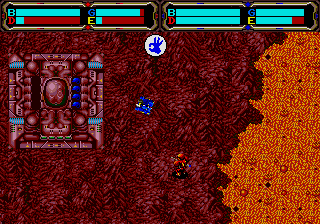 But back to Herzog Zwei! It’s awesome. You command a mech which can transform into an aircraft and your mission is to destroy the enemy’s main base while you take over minor smaller bases and protect your own main base. The more small bases you have (you take them over by sending four men into them), the more money you gain. And you use money to buy tanks, troops, turrets etc. and their commands. Some commands are cheap, like the stand still one, and others are expensive, like the one for attacking the main base. You can order one unit at a time, and as the aircraft you can place it. Be careful though, if you run out of fuel you lose the unit and have to wait a bit until you get a new aircraft. And wasting time is very risky.
But back to Herzog Zwei! It’s awesome. You command a mech which can transform into an aircraft and your mission is to destroy the enemy’s main base while you take over minor smaller bases and protect your own main base. The more small bases you have (you take them over by sending four men into them), the more money you gain. And you use money to buy tanks, troops, turrets etc. and their commands. Some commands are cheap, like the stand still one, and others are expensive, like the one for attacking the main base. You can order one unit at a time, and as the aircraft you can place it. Be careful though, if you run out of fuel you lose the unit and have to wait a bit until you get a new aircraft. And wasting time is very risky.
What makes this game a bit different from others in the same genre is the action element of the mech. You use it to take part of the action yourself, and not only command units to do so. I usually carry a tank to the main base and then transform into the mech to attack the defending enemies while the tank goes for the base itself.
I don’t know why Tecnosoft decided to name the game title and parts of it in German. Maybe they looked back and wanted to tribute their allies of WWII? Why else would the republic you fight in the game bear the German word for “aryan?” Either way, I can live with it, as the graphics are better than Hitler’s drawings and the music is very catchy (by far superior to The Magic Flute opera by Mozart I attended about a week ago). Maybe these comparisons aren’t fair since both Hitler and Mozart were Austrian. Then again, Austria was allied to Germany too.
What an unfair fate for Tecnosoft that Herzog Zwei didn’t become the big breakthrough for them it should have been. The video game industry is just as unfair as any war.
King Colossus By Frank Ramirez
Initially I was drawn to King Colossus because of its resemblance to Ys, and I’m a pretty big fan of that series. But all I’d seen were screen shots. I really wanted to give this one a try, and thanks to the translation efforts of MIJET, I could! There were times I forgot that this was a fan translation, and not a professional job. It’s THAT good. After playing the game, and recently completing it, I think it has a lot more in common with Quintet’s Illusion of Gaia on the SNES. It’s definitely a slower, more deliberately paced affair.
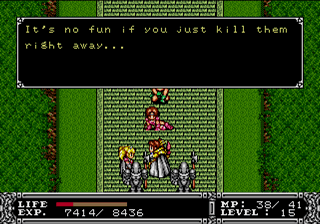 Now, the setting for this game has more of a sword & sandal feel to it, rather than your typical medieval backdrop, especially evident with cover art, depicting our hero who looks nothing at all like he does in game, raising his mighty sword aloft, leading what looks to be an army of warriors and magicians. The cover art does a wonderful job of conveying the general mood of the game, with designs that you would, again, find in a violent sword & sandal flick from the ’80s. This game definitely has a rather dark atmosphere, which was represented quite well with the sharp graphics offered, and don’t get me started on that haunting soundtrack! There weren’t too many tracks, but what was there was DAMN good. The graphics and audio both complimented the story told. While not exactly original or anything, what was there was pretty decent: a story of kingdoms falling under the rule of a corrupt Queen, shedding blood in the name of a dark god. There’s also plenty of back story, which is told, rather than in flashbacks, but through expository dialog via the many NPCs you’ll come across. It’s all a rather somber tale.
Now, the setting for this game has more of a sword & sandal feel to it, rather than your typical medieval backdrop, especially evident with cover art, depicting our hero who looks nothing at all like he does in game, raising his mighty sword aloft, leading what looks to be an army of warriors and magicians. The cover art does a wonderful job of conveying the general mood of the game, with designs that you would, again, find in a violent sword & sandal flick from the ’80s. This game definitely has a rather dark atmosphere, which was represented quite well with the sharp graphics offered, and don’t get me started on that haunting soundtrack! There weren’t too many tracks, but what was there was DAMN good. The graphics and audio both complimented the story told. While not exactly original or anything, what was there was pretty decent: a story of kingdoms falling under the rule of a corrupt Queen, shedding blood in the name of a dark god. There’s also plenty of back story, which is told, rather than in flashbacks, but through expository dialog via the many NPCs you’ll come across. It’s all a rather somber tale.
I do have ONE minor complaint, and I’m sure it was a point of contention with others; the hero plods along like he’s out to smell the damn roses. Again, minor, but it did get pretty annoying at times, especially in later dungeons with cavernous rooms. Aside from that, I really enjoyed this game. Great setting, FANTASTIC music, rather somber ending(s)… and does anyone else besides me think that the crest shown in the opening credits is totally tattoo worthy?
There was a lot going for King Colossus. During the end credits, a special thanks was given to a certain Phoenix Rie, aka Rieko Kodama, the mother of Phantasy Star. I’m pretty curious as to the extent of her involvement. In any case, it’s a damn shame that it was never localized back in the heyday of the Genesis. A BIG thank you to MIJET and his hard work!
RoboCop vs. the Terminator By KitsuneNight
What have I been playing this month ?Slop mostly, to be honest. I landed myself a list of awful games to review, and I have been hip deep, mired in them (King Of The Monsters and Super Thunder Blade are haunting my nightmares… brrr). But in between the garbage, I have been playing a few quality titles as well. Including today’s subject, the most violent game this side of Mortal Kombat II, RoboCop vs. The Terminator.
It’s probably one of the most violent games on the Mega Drive. People explode in geysers of blood or disappear back behind blood splattered curtains. And there was no moral “outrage”over the game back in the day. It nearly flew by under the radar. There is also some half-baked story, somewhat based on the Dark Horse mini series, written by Frank Miller and penciled by Walt Simonson, but the connections between the story are tenuous at best, beyond the title and Robocop smashing Terminators!
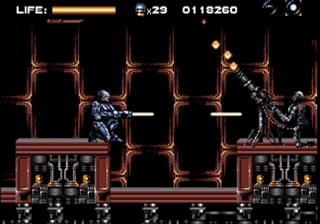 But is the game any good? Oh, yes. And is it hard? Oh, yes.
But is the game any good? Oh, yes. And is it hard? Oh, yes.
It is a gorgeous game to behold, taking full advantage of the limited palette of the Mega Drive. And portraying the world of RvsT, as a truly gritty unpleasant place, shaming the rather cartoony, brightly colored graphics of the SNES version in the progress. There is a gritty, unpleasant-but-realistic sheen over the graphics, from the muzzle flash reflected on Robocop’s chest and helmet and the color of the blood to the disturbing red flash of Terminator eyes and the dystopian future. (which is apparently only three years away). All this is offset by more cartoony elements, such as people exploding in a geyser of blood, which can only be ridiculous, and the chirpy music in the first two levels (with the equally chipper Terminator chorus). There’s also a hilarious, (and vaguely disturbing) end boss in the form of a huge endo-skeleton skull, which is supposedly the representation of Skynet. ED209 also makes an appearance, since it wouldn’t be RoboCop with out that thing. But unlike his usual outings, ED is actually a threat here!
Those skulls always give me the creeps at any rate.
RoboCop vs The Terminator is also brutally difficult, probably in line with its rather grim and over-the-top nature. One of the cheat codes is a 54 lives code. But even if you cheat one way or another or just play it without any cheats and get to grips with it, it’s a fairly short game that can be completed in 90 minutes or so. The other “cheat” is to hold on to the flamethrower and just keep shooting. The flamethrower stops every projectile and then suddenly the game is a lot easier, save for the bosses.
If you can find it for a reasonable price, its well worth getting. It’s a much better game then its SNES contemporary. Now if you will excuse me, I feel the need to terminate a few T800s.
Streets of Rage By Adam Holt
With the hubbub of the holidays finally behind me, I decided to relax in the depths of my man cave and fire up my trusty old Sega Genesis. For some reason, I had a hankering to use the official Sega Genesis arcade stick, so a suitable arcade-based game was in order. Oh, but what to choose among so many excellent contenders… Then it hit me like a grand uppercut, it was time for some Streets of Rage. It had been far too long since I last put time into that bad-boy, so I summoned my daughter, as beat-em-ups are better played with a partner, and we got to work. There’s nothing that can bring a family together like pummeling hundreds of bad guys.
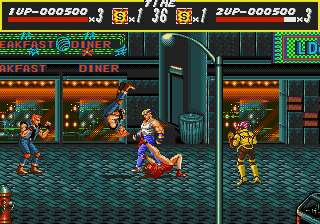 I chose Adam because that’s my name, and it’s so rare that I’m able to play with an eponymous character (I’m still bitter that he was removed from the sequels), and my daughter took the lovely Blaze. With power and speed, yin and yang, we were prepared to tear through all of the punks that Mr. X wanted to send our way. Now, as I have already mentioned, it had been years since I played SoR, but that didn’t seem to matter much as the game has a fairly low difficulty level. We were able to run the streets with relative ease. Sure there were some characters that gave us trouble, those dang fire-breathing fatties come to mind, but having a second player really makes the game much more manageable. Moreover, the beat-em-up style of game is simple for children to pick up and play, and my daughter was able to hold her own. We found that if we saved our specials for the level-end bosses, it made them much easier to take down; besides, it’s always satisfying seeing the cop car roll up and the officer fire his bazooka at the baddies.
I chose Adam because that’s my name, and it’s so rare that I’m able to play with an eponymous character (I’m still bitter that he was removed from the sequels), and my daughter took the lovely Blaze. With power and speed, yin and yang, we were prepared to tear through all of the punks that Mr. X wanted to send our way. Now, as I have already mentioned, it had been years since I played SoR, but that didn’t seem to matter much as the game has a fairly low difficulty level. We were able to run the streets with relative ease. Sure there were some characters that gave us trouble, those dang fire-breathing fatties come to mind, but having a second player really makes the game much more manageable. Moreover, the beat-em-up style of game is simple for children to pick up and play, and my daughter was able to hold her own. We found that if we saved our specials for the level-end bosses, it made them much easier to take down; besides, it’s always satisfying seeing the cop car roll up and the officer fire his bazooka at the baddies.
As far as the quality of the game is concerned, the feature of SoR that immediately jumps out is the outstanding music which sounded better than I had ever heard it before hooked up to my new stereo system. Certainly the soundtrack here is greater than that of either sequel. Graphically, the game has held up fairly well, although SoR2 is definitely superior in that department. I was impressed with the animations, however, and it looks better than many of its contemporary ’91 titles. The game is not all hunky dory, though, as there are a few nagging issues. For one, there is an insufferable pause one must endure prior to proceeding after a screen is cleared. It kept killing our momentum as we had to patiently wait for the little blinking arrow to appear time and time again. Also, the lack of diversity among enemies became quite obvious after a short while. Level after level, the same few characters are repeated with palette swaps. That is a general problem with the beat-em-up genre as a whole, though, so I can’t really hold it against SoR. Beat-em-ups: repetition be thy name.
Overall, SoR is a quality example of the genre and a true Genesis classic. The eight levels conclude with a white-knuckle boss gauntlet finale which will have your heart pounding and your brow perspiring. Plus, with the chance to see multiple endings depending on how your conversation with Mr. X goes, SoR has immediate replay value, and how many beat-em-ups can you say that about?
Traysia By David Dyne
Everybody has fond memories of playing video games when they were growing up at different times of the year. For me, two stand out in particular; skulking around lost in the dark in Sword of Vermillion’s dungeons in the summer and being lost yet again in Dezo’s Skure Spaceport in Phantasy Star 2 during the winter. With winter in full swing now I decided to check out Traysia, an RPG I never owned or even heard of back in the day.
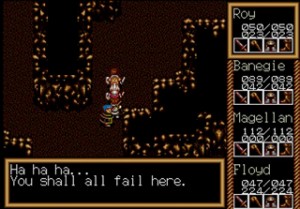 Traysia’s most striking component is its rich soundtrack that begins with a beautiful piece of music that accompanies the opening cut scenes which introduces us to Roy the main character of the story and his beloved Traysia as they are parting ways in a tearful goodbye. From there you have a number of memorable tracks such as the short but catchy combat theme, the friendly forest exploration theme in the first kingdom and the second kingdom’s harsh and desolate theme that plays as you explore the vast desert and mountainous wasteland, not to mention the ominous dungeon themes and the evil sounding northern temple tune.
Traysia’s most striking component is its rich soundtrack that begins with a beautiful piece of music that accompanies the opening cut scenes which introduces us to Roy the main character of the story and his beloved Traysia as they are parting ways in a tearful goodbye. From there you have a number of memorable tracks such as the short but catchy combat theme, the friendly forest exploration theme in the first kingdom and the second kingdom’s harsh and desolate theme that plays as you explore the vast desert and mountainous wasteland, not to mention the ominous dungeon themes and the evil sounding northern temple tune.
The set up in this game is different from most RPG’s as there is no massive overworld to travel around in. You’re given a single area to complete a number of quests in and once those are done you’ll automatically move to the next area to begin the process again with no method of going back. There’s no teleportation magic so you’ll be doing a fair bit of back tracking to locations, but that’s okay as it gives you more time to enjoy the soundtrack. I’ve only just started exploring the third kingdom with its thirteen towns, and so far it’s been a real treat despite the sluggish menus, stuttering scrolling and simplistic combat system where you’ll never need to cast a spell to help win a battle.

Recent Comments